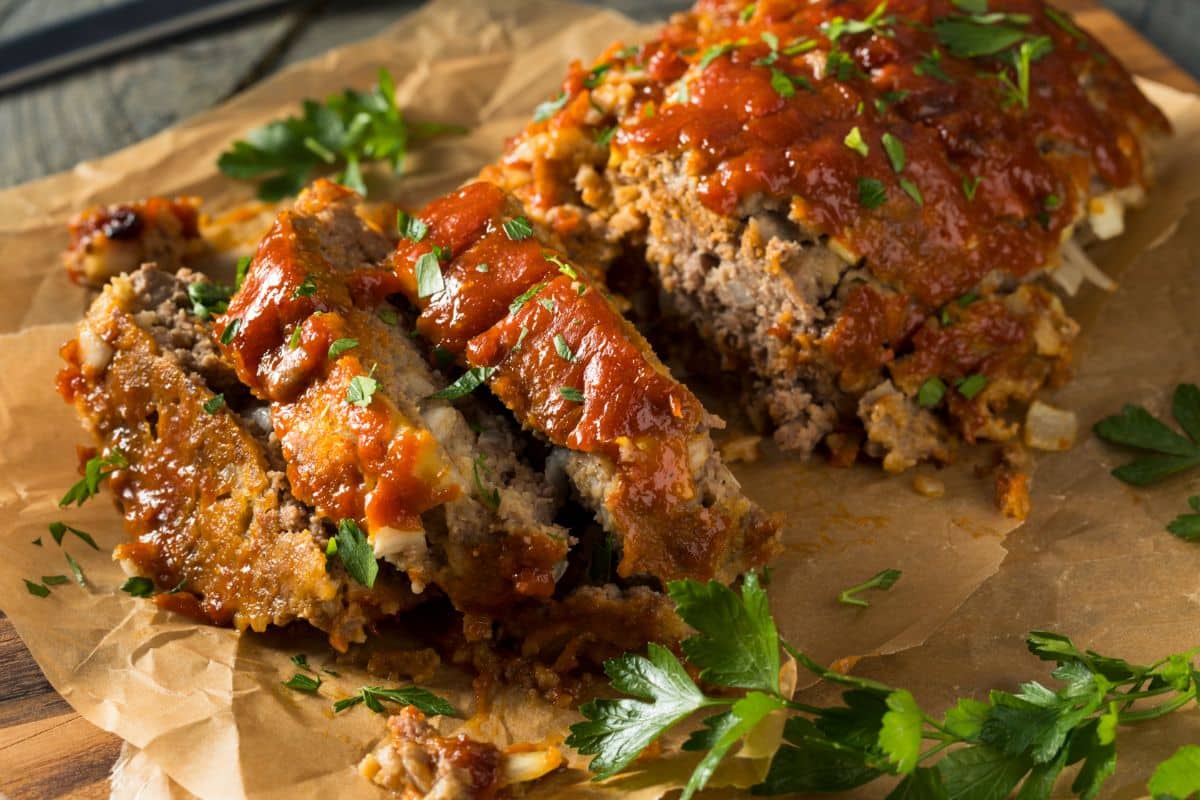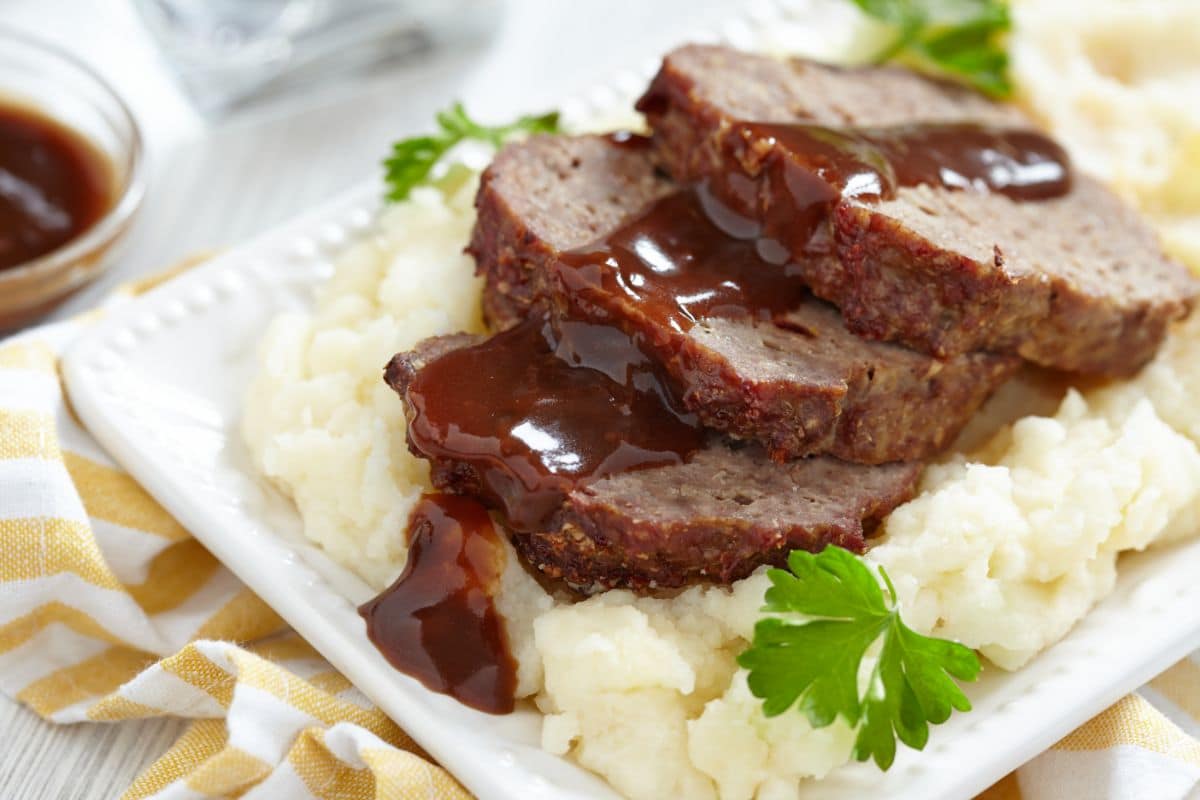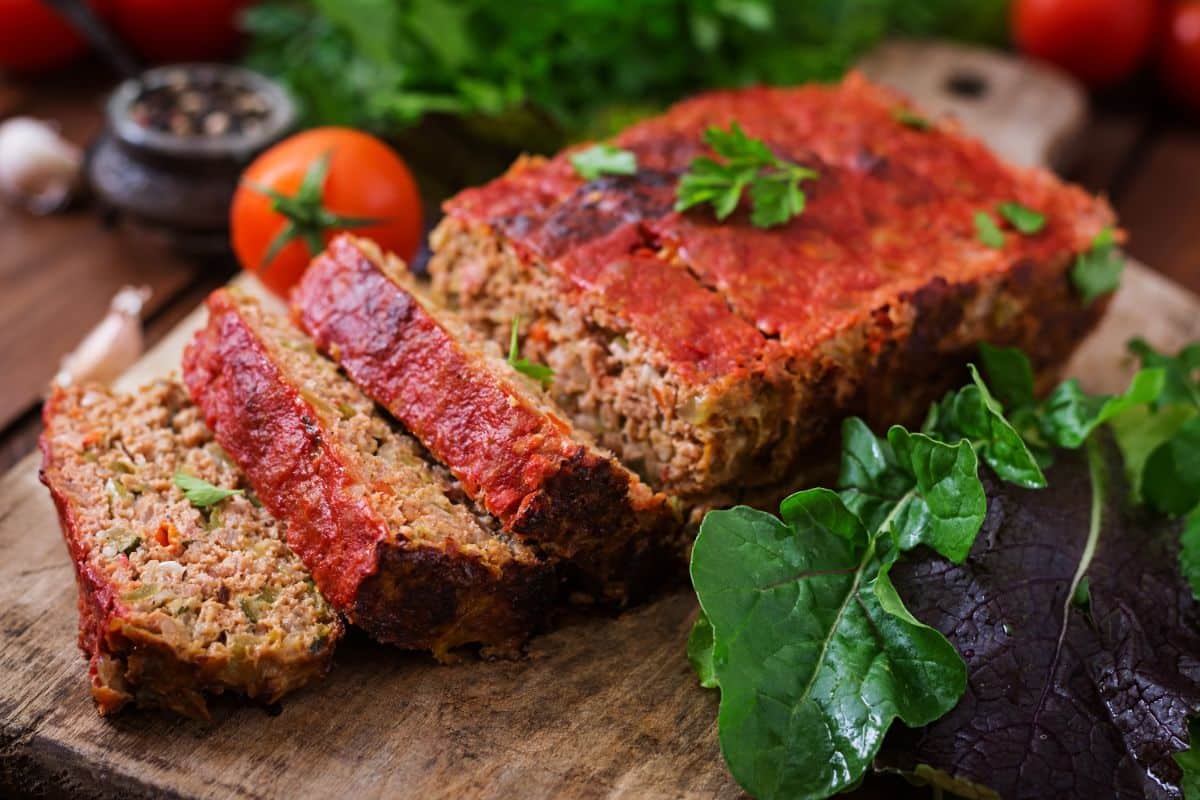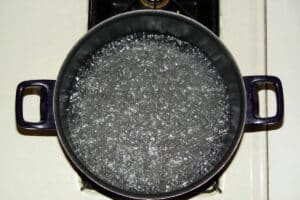Who doesn’t love meatloaf? It’s one of those family favorites that everyone looks forward to. And with good reason really, it’s filling and downright delicious.

And in terms of preparations and cooking methods, it’s a relatively simple meal to cook too. Win-Win.
The only real issue that most individuals struggle with is actually knowing when it’s ready to pull out the oven and serve.
Do it too early and you risk tucking into undercooked meat which is never a good idea. Do it too late and you’ll end up with a burnt, dry, and unappetizing meal. Which isn’t ideal either.
Generally, following the recipe time instructions and using a meat thermometer to check the internal temperature before serving is the most reliable way of ensuring that your meatloaf is ready to be devoured.
But there are a few other tips and tricks that will work well.
And luckily, in this article, we’re going to go over everything you need to know in terms of meatloaf, so you’ll definitely want to stick around.
What Is Meatloaf?
So, just in case you haven’t heard of meatloaf before, let’s actually explain what it is.
Simply put, it is a variety of ground meat that is then mixed together with a variety of other ingredients which is then baked or smoked in a loaf-like shape.
Most commonly, the ground meat of choice will be beef, as this is the more traditional ingredient, but many adaptations of the recipe include lamb, pork, turkey, or even venison or seafood.
Once baked, it is then often sliced into smaller portions for serving. A little bit like cutting slices of bread.
It can then be served as it is or with a selection of sides depending on how hungry you are, we suppose.
How To Make Your Own Meatloaf From Scratch
In grocery stores, you can usually find pre-made versions of pretty much any meal, and sure, this will do just fine, but there’s just something about a meatloaf that is cooked with love that tastes so much better.
If you’ve never braved giving meatloaf a go from scratch, take this as your sign to do so.
Honestly, it’s really not that hard to do yourself at all so you shouldn’t encounter many issues at all. But the reward is well worth it even if there are.
All that will be required of you is to grab a big mixing bowl, chuck all your ingredients in, combine them thoroughly, and then squidge them into the shape of a loaf, and voila.
Now, we understand that’s a little vague, so don’t worry, there’s a full recipe for you to follow below.
Amazing Meatloaf Recipe
Ingredients
- Ground Meat (beef in this instance) – 1.5lbs
- Egg – 1
- Oatmeal – 1 cup
- Milk – ¾ cup
- Mrs. Grass Onion Mushroom Soup Mix – 1 packet
Directions
- Preheat – Preheat your oven to 400 degrees Fahrenheit
- Add – Add all of your ingredients to a large mixing bowl
- Mix – By hand combine all of your ingredients together (be careful not to over-mix)
- Form – Grab an oven-safe baking dish and mold the meat mixture into the shape of a loaf (be careful not to over-pack it)
- Cover – Cover the meatloaf with foil
- Bake – Bake your meatloaf in the oven for 45 minutes
- Uncover – Remove the foil and place it back in the oven
- Bake – Bake for a further 15 minutes (until the meatloaf reaches an internal temperature of 155 degrees Fahrenheit)
- Remove – Remove from the oven and set it to the side to rest for 10 minutes
- Serve – And just like that you’re all ready to slice up, serve, and tuck in.
The Basic Formula Of Meatloaf That You Need To Know
While meatloaf is a relatively easy meal to make, you do have to be really careful when it comes to the ratio of ingredients, particularly the milk and the oatmeal.
You see, too much milk and you’ll end up with a sloshy wet and soggy meatloaf.
Whereas with too much oatmeal, you’ll have a chalky and dry meatloaf lacking that delicious tender and moist texture. So getting the ratio right is really imperative.
So, let’s take a look at the basic formula of a moreish meatloaf that you’ll want to eat over and over again.
Ground Meat
Okay, so you’ll want to select your ground meat of choice. We’re going to talk about beef since it is the most popular and common choice but feel free to add your favorite meat to the mix should you wish.
When it comes to picking your ground meat, you want to choose a variety that is good quality. We recommend 80/20 beef like Ground Chuck.
This works really well and helps create a juicy, tender, and downright delicious meatloaf.
Vegetables
Vegetables don’t always have to be in meatloaf, but many individuals enjoy their additional flavor. It’s also a great way to incorporate some of your five-a-day into your meals without children even realizing it!
Veggies such as carrots, celery, or onions work really well in meatloaf, but you can choose any vegetable you enjoy.
The only advice to keep in mind is that you should always finely dice and saute them before adding them to the mixture, otherwise, they can hinder the taste and texture of the meatloaf as they may not cook fully in the meatloaf.
The Glaze
It’s definitely not uncommon for individuals to baste their scrumptious meatloaf with some form of delicious glaze.
Again, a little like the veggies, it’s not absolutely necessary, but it certainly elevates and enhances the dish making it a good option to go with.
The choice of whether to include a glaze or not is entirely up to you, but if you do opt for a glaze, be it ketchup, barbecue sauce, or something entirely different, be sure to only add it in the final 15 minutes of cooking.
If you add your glaze from the beginning it’s likely to burn and add an unpleasant-tasting crispiness to your meatloaf that is far from ideal. Adding it near the end ensures that it stays as a glaze and doesn’t overcook.
How To Tell When Meatloaf Is Cooked
Okay, so below we’re going to outline some of the tricks of the trade for checking whether or not your meatloaf is cooked.
It’s important to note though before we begin, that not every single tip will work for you, and some are more effective than others.
Really, it’ll come down to which methods are best for you.
And overall, the best and most reliable way to know that your meatloaf is done is to use a meat thermometer to check that it has reached an internal temperature of 155 degrees Fahrenheit.
Use A Metal Cake Tester
This method is probably as close in effectiveness as you’re going to get to the meat thermometer.
The tool is very similar, the only real difference is that it is often used to read the temperature of sweet baked goods rather than meat.
However, as long as it still gives you that 155 degrees Fahrenheit reading, then you know that you’re good to go.
Use An Instant-Read Thermometer
We did just touch on this above, but we will reiterate the point. The most effective way to know that your meat is cooked is to use an instant-read meat thermometer.
You can gently insert this into your meatloaf and as long as it reaches a temperature of 155 degrees Fahrenheit you’ll be good to go.
This will also give you the most peace of mind if you are nervous about whether or not your meatloaf is ready to serve since you’ll get an accurate reading of the exact temperature of the meat.
However, if you do not have access to an instant-read thermometer, you can follow the time instructions of your recipe and then use any of the following methods to determine whether or not your food is cooked.
But do please keep in mind that these are less certain and reliable methods.
Use The Fork Method
Once your meatloaf has been in the oven for the allotted time, you can check to see how cooked it is by using a fork.
It’s a handy option for those with fewer resources or tools in their kitchen since pretty much everyone has a fork to hand.
What you’ll want to do is insert the fork into the middle of the meatloaf at the thickest section. You should make sure that your fork reaches the center of the loaf.
If the fork moves through the meatloaf easily and seamlessly, it’s a fairly good indicator that it’s ready to eat.
However, you can also double-check by giving the fork a touch test. If the fork is hot-warm to the touch then it should be good to go.
If it requires effort or force to slide the fork through the meat, or it comes out cold, it’s not quite ready yet and you should pop it back in the oven for around 10-15 minutes and then repeat the process as necessary.
Use The Finger Method
Don’t worry, we’re not asking you to substitute a fork for a finger in this instance. Firstly, that would be pretty reckless and dangerous and is a great way to burn a finger.
Secondly, it’s going to leave you with a finger-sized hole in your meatloaf that would seriously ruin its presentation.
Instead, you’re going to wash your hands, no one wants to eat meatloaf covered in grubby finger marks, and then you’re going to gently touch the top of the meatloaf.
If it’s nice and firm, then it’s likely ready for serving, however, if it’s still a bit squishy and squidgy, then it’s going to need some more time in the oven.
Chuck it back in for around 10-15 minutes and then repeat the process as necessary.
Follow Your Recipes Time Instructions & Trust Your Instincts
Overall, there are a few different methods you can try, but for the most part, as long as you follow the instructions of your recipe exactly, it should be fine.
These recipes have particular timings for a reason and that’s usually to ensure that the food is ready and safe to eat.
From the appearance and smell, you can usually gauge if the meatloaf needs a few more minutes, and if your instincts tell you that it’s not quite ready, chances are that it’s not.
So, follow your instructions and instincts, and then where possible try to follow some of these methods for some added confirmation.
How Long Can Meatloaf Sit Out Before It Goes Bad?

Not that long at all, really. In terms of health and safety, it’s never really a good idea to let cooked food of any kind sit out for long periods of time.
When it comes to meatloaf, regardless of its size, it should never be left out for over two hours.
This is because bacteria can start to breed in the food and this can have pretty disastrous consequences.
And this is true regardless of the type of meatloaf you’ve made whether it be chicken, beef, seafood, or something entirely different.
Can Bad Meatloaf Make You Sick?
Indeed it can. As we mentioned above, when food is left out for too long, it can lower to the perfect temperature for bacteria to breed.
Obviously, this bacteria is too small for the naked eye to see so it’s not something you’ll notice while you eat it, but you definitely will within 12 hours or so.
Consuming food that is filled with bacteria is a pretty good way to get a nasty bout of food poisoning.
And this can make you sick, it can cause diarrhea and a whole host of other unpleasant side effects.
So, if you’ve left your meatloaf out for a little too long, it’s better to cut your losses and be safe rather than sorry.
Can Undercooked Meatloaf Make You Sick?
Just like consuming any other meal that is undercooked, eating meatloaf that has not been fully cooked can cause you to become pretty ill.
And it’s much for the same reasons as above. Heating your meat helps to destroy those nasty bacteria that are responsible for food poisoning.
This is why it is so important to remember those all-important numbers. 155-160 degrees Fahrenheit.
They will ensure that all the nasty bacteria have been destroyed and thus you won’t get poorly.
How Long Should You Let Meatloaf Rest?
Resting your meatloaf is a really important part of the cooking process.
Sometimes we can be a little too eager to start tucking in and just want to serve it straight up. But this is a great way to ensure a crumbling piece of mess that doesn’t slice well.
Allowing meatloaf to rest allows it to bond together before serving.
Usually, around 10-15 minutes of resting should be more than enough, but you can leave it for a little longer should you wish.
What Is The Ideal Cooking Temperature For Meatloaf?
Generally, cooking your meatloaf at a temperature of 400 degrees Fahrenheit is the ideal temperature.
However, the actual oven temperature is much less important than the internal temperature of the meat itself.
As we’ve mentioned in this article, the optimal temperature to remove your meatloaf from the oven is 155 degrees Fahrenheit. This is because the meatloaf will continue to cook as it is resting.
If you wait for your meatloaf to reach 160 degrees Fahrenheit before removing it, it is likely that during the resting period, it will overcook and thus become tougher and less appetizing when it comes to eating it.
Why Is Your Meatloaf Sometimes So Watery?
Usually, if your meatloaf is a little soggy or watery it’s because your ratios were off somewhat during the mixing or preparation stage.
In this case, it is likely that you’ve added a little too much milk, breadcrumbs, or oatmeal in comparison to the amount of meat that you’ve used.
Luckily, this can be fixed! Hooray! All you’ll need to do is add a little extra beef or use less of the other ingredients when mixing them all together.
Why Is Your Meatloaf Sometimes A Pink Color?
If you slice up your meatloaf and notice that the beef has a slightly pink hue to it, it can be pretty jarring.
But don’t worry, this doesn’t always mean that it is undercooked. The meatloaf can often contain extra nitrates that can cause discoloration.
As long as your food reaches an internal temperature of 155-160 degrees Fahrenheit, then it is safe and ready to eat regardless of its color.
Meatloaf Cooking Tips
We all recognize what the perfect meatloaf looks, feels, and tastes like, right? It should be just a little crusty and crunchy on the outside and then should be moist and tender on the inside.
That right there is the ideal meatloaf. So, what are our top tips for producing the perfect meatloaf? Let’s take a look.
Cook Your Veggies
We mentioned this briefly above, but it’s such a vital tip we thought we’d just reiterate the point.
If you’re adding a medley of delicious vegetables to the mixture, you need to make sure that they are finely diced and fully cooked before you add them.
This is because sometimes the vegetables don’t cook at the same rate as the other ingredients in the meatloaf. So added uncooked vegetables can sometimes still come out of the oven uncooked.
This will add an undesired crunch to the texture of the meatloaf, and you won’t get the most out of the flavor of your veggies either.
Keep Your Shaping Loose
When you’re shaping your meat mixture into a loaf, do so with a light touch. You’re not trying to shape your meat into a small, tight, packed shape.
That will cause the meat to cook slower and will also eradicate any chance of that moist and tender texture.
Instead gently molding it into the shape and leaving it loose allows for a quicker cook and a more moist meatloaf.
Taste-Test Your Mixture
If you’ve been particularly inventive with your flavoring, or haven’t followed a recipe exactly, it may be worth tasting a very small portion of it before you cook the whole thing.
Now, just to be clear, we’re not recommending that you munch a small portion of uncooked meat – we don’t want any food poisoning here – but instead that you quickly fry up a small portion of the meat just to ensure that it’s up to your standards.
This way, you can make any necessary adjustments before you cook the entire thing.
How Long To Cook Meatloaf
Exactly how long you’ll cook your meatloaf will depend entirely on the size of your meatloaf.
For example, a small meatloaf expected to feed two or three people is going to cook much faster than a larger meatloaf expected to feed six or seven.
As a general rule, though, smaller meatloaves that are around 1-1.5 pounds in weight will usually take an hour to cook at 400 degrees Fahrenheit.
Then, the larger 2-2.5 pound meatloaves will take around 80 minutes or more to cook at the same oven temperature.
As a guide, you’re best allotting around 30-40 minutes for each pound of meat when you’re cooking at 400 degrees Fahrenheit.
This should ensure that you reach that vital 160 degrees Fahrenheit internal temperature and that it is safe and ready to eat.
How Long To Cook Meatloaf In A Smoker
If you’re lucky enough to have a smoker, this is another amazing cooking method that produces the perfect meatloaf.
It does take a fair bit longer than it does in the oven, but the quality of the meal is well worth the wait.
You’ll want to set your smoker to around 225-250 degrees Fahrenheit and then allow the meat to cook for anywhere between 2 and a half hours to three hours.
Again, we recognize that this is a much longer cooking time but slow and steady wins the race in this case.
As with cooking in the oven, you’re going to want to ensure that the meatloaf reaches an internal temperature of 160 degrees Fahrenheit so that it is safe to eat.
Ideally, you’ll prepare and preheat your smoker before you put it in, and a combination of apple and hickory wood chips works the best in terms of adding extra flavor.
After around the two-hour mark, you’ll want to pull the meatloaf out and brush it with either barbecue sauce or a different glazing of your choice, then once you’ve done this you can place it back in the smoker and let it cook the rest of the way.
What Is The Best Pan To Use For Meatloaf?

Unfortunately, there isn’t an exact black-and-white answer to this question. At the risk of sounding a little vague, it’s simply whichever pan gives you the best results.
In most instances, though, it’s not really necessary to purchase a new pan specifically for meatloaf, it’s likely that you have one lying around at home that will do the job perfectly well.
If you’re looking for a little inspiration though, often individuals will opt for some type of loaf pan similar to the ones you’d use to bake bread or certain cakes.
Alternatively, a baking dish or cake pan will work just as well, if not better, since there is extra space for foil on the top and the extra space on the pan edges allows a little extra air circulation, and also allows the grease to roll off, and thus creates an even and effectively cooked meatloaf.
Really, the only absolute requirement for your meatloaf pan is to ensure that the pan has edges so that the grease doesn’t drip down your oven.
The Qualities Of The Perfect Meatloaf
Okay, so let’s take a look at all the qualities your meatloaf should possess to be officially crowned the perfect meatloaf.
Moist Meatloaf
The ultimate goal is to create a meatloaf that has just a hint of a crust on the outside and is tender and moist in the middle.
But doing so can be a little difficult, it may take some trial and error to get there.
This is because you don’t want the meatloaf to be so moist that it becomes soggy or so crusty that it becomes tough and dry. It’s all about getting it just right.
Meatloaf That Isn’t Soggy
So, as we just mentioned, you want your meatloaf to be moist but not so much so that it becomes soggy or sloppy. That’s just not appetizing for anybody.
A great way to combat sogginess is to use a freeform pan that allows the grease to flow away from the meatloaf itself.
So, if you’re opting for a loaf pan you need to make sure that it doesn’t come right to the edges of the pan as this will not allow the grease to escape and thus will create that overly soggy meatloaf that you’re trying to avoid.
Meatloaf That Is Full Of Flavor
Bland and boring meatloaf is far from perfection. The spices and herbs that you choose to use are completely up to you, after all, it’s a case of personal preference, but just ensure that there is some form of herbs and spices in the mix to ensure that it bursts full of flavor.
You can make your own medley if you’re confident in your own abilities, but if you are new to the cooking scene or are a little unsure of what to use you can always opt for a premade seasoning packet instead.
You should be able to find these in most supermarkets and grocery stores so they are easily accessible.
Meatloaf That Slices Easily
It’s really there in the name, meatloaf is a loaf of meat, and you should be able to slice it in a similar way that you slice bread for serving portions.
And with the perfect meatloaf, you should be able to do so with ease.
It shouldn’t crumble apart as you try to slice it nor should it be super dense when you try to portion it out.
Crumbling is usually a ratio issue, and we’ve spoken a lot about how the preparation stage is important in this case.
Providing you’ve followed a recipe or got your ratios of ingredients correct, your meatloaf should not crumble. If it does, it’s an indicator that something went wrong during the mixing process.
Then if your meatloaf is overly dense, it’s probably from over-packing your meatloaf when shaping it which is why in this article we have encouraged you not to use a heavy hand during this process. Leaving the loaf loose should help you avoid this issue.
Meatloaf That Has A Delectable Outer Crust
Everyone has their personal preferences, but we think that the perfect meatloaf is never complete unless it has that slightly crispy and somewhat crunchy outer crust to it.
When it comes to getting that delectable crust, you’ll want to use a free-forming pan as this will be the most effective way to achieve it.
However, you may prefer to opt for a scrumptious glaze instead, and there are several options out there to choose from. Barbecue sauce is always a popular choice, as well as ketchup.
Or alternatively, you could go for something a little more outside the box such as a bacon-wrapped crust…yum!
The Moist-Making Secrets To A Tender Meatloaf
Okay, so we’ve gone on and on and on about how a perfectly moist meatloaf is the best meatloaf there can be.
But what can you do to actually achieve this? Well, below you’ll find some of our best secrets for producing an amazingly moist meatloaf.
Fat Is Your Best Friend
Usually, we try to avoid fat at all costs, right? Well, not when you’re making meatloaf.
Fat is one of the best components to ensure moisture retention while cooking and thus producing a perfectly moist meatloaf that is neither soggy nor dry.
The secret here is to ensure that you are using good quality ingredients, especially in terms of your meat.
If you’re opting for ground beef, you’ll want to choose 80/20 ground beef such as Ground Chuck. This way there will still be some fat present to lock in all that scrumptious moisture in your meatloaf.
Vegetables Are Good Friends Too
There’s never a downside to eating your veggies. Not only are they a great source of all those much-needed nutrients that our bodies require, but they also help to boost both the texture and flavor.
Just remember what we said before about cooking your veggies first. Otherwise, you’ll do the exact opposite of what you’re trying to achieve.
Use Enough Of Your Filler
What is the filler you ask? It’s your oatmeal, or breadcrumbs, or whatever similar ingredient that you’ve chosen.
Though this is often what they are referred to, they actually do a much more important job.
These ingredients are able to soak up the meat juices in the mixture like a sponge, and this helps to keep your meatloaf nice and moist.
Don’t Over Mix Or Compress Your Meat
We know you’re probably tired of hearing us tell you not to over-mix or over-compress your meat by now. We’re aware we’ve mentioned it several times. But this is simply because it is so important.
Both of these things will result in your meatloaf becoming tough, dry, and near enough inedible, so they’re massive mistakes to try and avoid if you can.
Keep Things Slow And Low
And by this we mean the temperature of your oven.
Yes, cranking your oven up to high heat does help food to cook quicker, and it can be tempting to do so, especially when you’re hungry, but it’s also a surefire way to ruin your meatloaf.
Keeping the heat low and cooking it for longer will produce the most tender and moist meatloaf and therefore it is always better to wrestle with your impatience. We promise it’ll be worth the wait.
Meatloaf Leftovers
If your eyes are a little bit bigger than your belly, and you end up with leftover meatloaf, don’t throw it away. You can definitely keep it and reheat it at a later date.
You will want to keep in mind that, as with anything, the quality of the food won’t be quite as good as it was when it was fresh.
But with that being said, it’s definitely still edible and will still taste nice…just not quite as nice.
How To Store Leftover Meatloaf
Storing leftover meatloaf is a very easy and straightforward process.
Simply cut into portions, store in an airtight container, and then place in the refrigerator. You’ll just need to make sure that you eat it within the next three days.
If you don’t think that you’ll fancy your meatloaf within the next three days, then you could always opt to freeze it instead.
To do so, you’ll want to place your meatloaf in a ziplock bag and then place this into an airtight container before placing it in the freezer.
It should keep for around three months in the freezer so you’ll definitely have a longer shelf life this way. Just be sure to label your container so you know when it’s gone out of date.
Once you’re then ready to tuck into your meatloaf, you’ll want to grab it out the night before you intend to eat it.
Place it in the refrigerator and allow it to thaw overnight. Then you’ll obviously need to reheat it before tucking in.
How To Reheat Meatloaf
There are several different methods you can use to reheat your meatloaf but by far the most effective is baking it again in the oven.
This will take a little longer but it does help to ensure that you retain the moisture and keep that delightful texture and taste.
To reheat meatloaf in the oven simply bake at 250 degrees Fahrenheit for 25 minutes.
Another pretty great option is to use an air fryer if you have access to one. Turn your air fryer to around 350 degrees Fahrenheit and then line the basket with baking paper.
Give each side of the meatloaf a spritz of oil and then cook for around 4-5 minutes per slice.
You could also use other methods such as steaming or microwave cooking, but these tend to impede both the texture and flavor leaving it a little less appealing to eat.
If you’re reheating your meatloaf in the microwave you’ll want to place a singular slice onto a microwave-safe dish and then cover it with a sheet of damp kitchen paper to help retain the moisture.
Then reheat for one minute before turning it over and reheating for a further one minute. Take it out and see if it is hot enough, if not continue to reheat the process until it is piping hot.
Can You Make Meatloaf In Advance?
Yes, you can! Making meatloaf ahead of time can be very convenient if you don’t have the time to prepare it the day you plan on eating it, but the only disadvantage of doing so is that it won’t taste quite as delicious as it would if you had made it fresh.
With that being said, though, it can still taste pretty great. And a pretty great meatloaf is better than no meatloaf at all.
When it comes to making meatloaf ahead of time, there are a few different ways you can go about it. The first option is that you can follow the recipe right up until the cooking process.
So, you’ll mix your meat, season it, and form it into your free-form pan.
But then instead of it heading for the oven, you’ll wrap it up in a plastic wrap, store it in an airtight container, and then leave it in the refrigerator until you’re ready to bake it.
Or alternatively, you can follow the same instructions as above but instead of moving it to the refrigerator, you can store it in a zip-lock bag, place it in an airtight container, and then place it in the freezer until you are ready to bake it.
This is a good option if you don’t plan on actually cooking the meatloaf in the next few days. But just remember that you will need to pull it out and thaw it the night before you intend to cook it.
Then finally, you could always follow the recipe entirely including baking it in the oven, and then choose to store it in the freezer and then just thaw and reheat at a later date.
This will deteriorate the quality somewhat, but it does speed up the cooking time and make it a more convenient option if you are pressed for time.
What To Serve With Meatloaf
Now that you know everything there is to know about meatloaf preparation, the only question that you might have left is: what exactly should I serve with my meatloaf?
Well, the choice is entirely up to you. There are no rules so, really, you could serve it with whatever you would like.
But let’s take a look at a few ideas so that you can get some inspiration for your next meal.
- Potatoes – You can never go wrong with a side of potatoes and there are so many different options to choose from. Our personal favorite is some super creamy and buttery mashed potatoes. But you could also opt for some fluffy baked potatoes, crunchy and well-seasoned roast potatoes, sweet potatoes, scalloped potatoes, or even fries if you feel like it.
- Vegetables – Not only are veggies super delicious and packed full of flavor, but they also contain all the nutrients that help keep our bodies healthy and strong, so adding them to any meal is always a good idea. Options such as green beans, broccoli, asparagus, or sweetcorn pair really well with meatloaf.
- Bread – You can never beat a bit of bread when you have meatloaf. Dinner rolls are always a great staple besides a meatloaf, but you could also opt for biscuits, cornmeal muffins, or even a slice or two of garlic bread if you want something with a little extra flavor.
Final Thoughts
And there you have it – you should now be an absolute meatloaf pro. The student has become the master – there is nothing else to learn.
Hopefully, from reading this article you should have a much better understanding of not only how to know when meatloaf is ready and safe to eat, but also how to produce the best-tasting meatloaf you’ve ever attempted.
But considering we’ve thrown quite a lot of information at you today, shall we do a quick recap?
The best way to know that your meatloaf is ready to eat is to check its internal temperature which should be between 155-160 degrees Fahrenheit.
You can also double-check to check it’s ready by popping a fork in it to check that it’s easy to get through and warm, or you can touch the top with your finger to see if it’s firm.
Meatloaf can also be made ahead, reheated, and stored for later use.
Checking your ratios, using a freeform pan, and not overpacking or mixing the ingredients will also ensure it stays nice and moist.
So, what are you waiting for? Make your next meatloaf today and watch as it comes out amazingly well!







